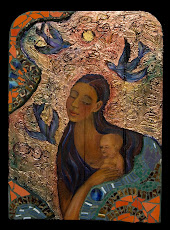
This exhibit is up for Summer 2009. The artist statement describes the personal context of my art and about the intent behind these pieces.
_______________________________________________________________
Reshaping the Divine: Contemporary Hispanic Retablos Exploring the Sacred Feminine
Cristina Ortiz Acosta – Artist Statement 2009 - Exhibit at El Museo Cultural, Santa Fe, New Mexico. Click here to see this series of Hispanic Retablos.
Over the past twenty years, my series of Madonna retablos came to me in ebbs and flows via a series of powerful dreams. The dreams started during my pregnancy with my daughter. For the entire pregnancy I dreamt of being a woman on a journey north across dusty plains and through arroyos as I mostly walked behind an oxcart. The dreams ended in a room lit by a wooden candelabra filled with tallow candles and the birth of my daughter, Isabella Pilar in 1993.
I called these dreams my Maria Dreams because in the dreams, I/she was named Maria. Seeking the meaning of those dreams over the years brought me down a path I could never have imagined and deepened my understanding of my cultural heritage. Searching for the meaning of my Maria Dreams eventually lead me back to New Mexico, the land of my Ortiz ancestors.
My paternal grandmother, Catalina Maria Ortiz Acosta, born in 1904, was the daughter of J. Nestor Ortiz and Maria Elena Salazar, descendents of the original Spanish settlers founding the cities and villages throughout New Mexico. Researching my family genealogy (my grandmother spoke vaguely about her ancestors), I discovered that my direct ancestors had participated in the initial 16th and 17th century migrations of the Spanish, traveling North from Mexico City into the region that is now the State of New Mexico. I read books about the era and became fascinated by the types of experiences my female ancestors must have had while living on the New Mexican frontier for generations. With this research nurturing my experience of my personal history, my calling to paint Madonna’s began to take shape.
Born in Los Angeles to an Anglo mother and Hispanic father, early on I was aware of cultural concepts because of the differences between the two sides of my family. Despite their differences, Catholicism was the central theme for my parents. Celebrating their devotion resulted in religious images from the Americas and Europe scattered throughout our home and those of our relatives. Images of Mary the Mother of God as the Guadalupe, Conquistadora and many other versions were always present. Along with those images were displayed American Indian items from the Ortiz ranch.
The artifacts from the Ortiz family ranch consumed my imagination from as far back as I can remember. Handmade Indian blankets and pots, and even a gold menorah (referred to as a “candelabra” by my grandmother) made by Ortiz ancestors generations past (some of the men were renowned filigree gold smiths). Those as well as the chili ristras hanging in my grandmother’s kitchen hinted at another world far from the Southern California beach scene of my childhood home. For reasons I can’t sufficiently articulate, the mix of these images and experiences coalesced into my c
 alling to visually explore and create new images of the Madonna as an expression of the feminine divine.
alling to visually explore and create new images of the Madonna as an expression of the feminine divine.Each of the retablos I paint results in a new vision of the sacred. For example, painting La Conquistadora opened the door to re-balancing the dominant patriarchal and European view of the divine with the North American native and feminine. In La Conquistadora I layer symbols of the Dine Spider woman and the Puebloan Corn Maiden, seeking to blend the indigenous ancient female images and concepts harmoniously with the Catholic image of Mary. The result is a Madonna that hints of ancient goddesses many thousands of years old at the same time she conveys the current blend of cultures in the Southwest.
I create my work in the traditions of the Spanish/Mexican retablo to reinforce my expression of reverence and convey the intimate experience of sacredness. I find antique, reclaimed timbers for the substrate. I mix gold, silver and copper metals into my oil paintings to both embellish the image and in homage to the gifts my ancestors created for me with their existence. The vintage gold glazed ceramic tiles come from a tile company that operated near my childhood home in Southern California during the 1950’s and 60’s. When I finish a retablo, I write a blessing on the backside of the retablo to convey love to all who view the images.
My Maria Dreams from over a decade ago continue to influence this series of work. May you find your own meanings and blessings within these images.
www.CristinaAcosta.com

















Cxristina, your artwork is inspiring and touches my girlhood's Catholic heart. WOW. Thank you for sharing.
ReplyDeleteThank you Ananda!
ReplyDelete